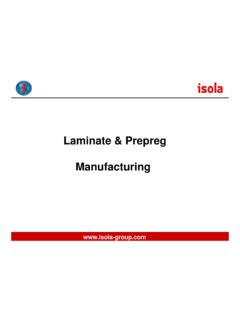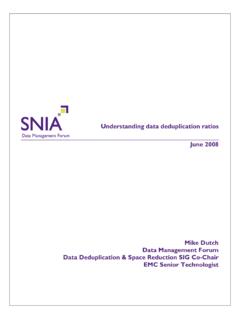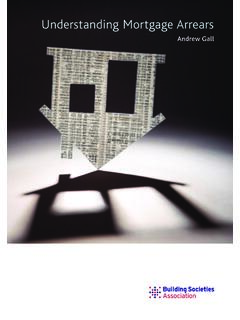Transcription of Understanding the Use and Applications of Shock Response ...
1 Understanding THE USE AND APPLICATIONSOF Shock Response spectrum METHODCLAUDIE HUTIN DATA PHYSICS (France)INTRODUCTIOND efinition of the Shock Response SpectrumShock tests are performed to verify that a structure or a device can support transient vibrations encountered during its lifein real environmental conditions One of the Shock testing formats is the Shock Response spectrum . Shock ResponseSpectrum (SRS) analysis is, by definition, the maximum Response of a series of Single Degree Of Freedom (SDOF)systems of same damping to a given transient degree of freedom is defined as the ability to move along or around only one axis. These SDOF systems are selectedas a reference to analyse transient phenomena. Instead of analysing them by FFT process, the SRS uses anothermathematical tool provided by this SDOF reference.
2 Indeed, the FFT algorithm is not suited to non-stationary signals ofshort duration and one states the hypothesis that due to the shortness of the vibrations, the severity can be characterise bytheir maximum effects on the SDOF principleEven if the selected reference (SDOF systems) does not represent the equipment to be tested, we can assume that if twodifferent excitations have the same severity (SRS), they will induce equivalent effects on this notion of equivalence is at the origin of the using of the SRS because a synthesised pulse can replace a complexexcitation whose severity is the same. Typical Applications are: simulation of gunfire, launching, seismic, military aircrafttaking off or landing testing provides the ability to synthesise a complex waveform that can be applied to electrodynamic orelectrohydraulic exciters in a controlled manner with consistent repeatability avoiding the using of Shock machines thatlimit the shape of the excitation pulse.
3 The severity of the test is maximised using SRS of a generalised qualificationThe qualification of equipment is often performed using a record of its specific vibration procedure must take into account the particular conditions of the records:q Possible evolutions of some parametersq Uncertainties on the source of excitationq Location of the equipmentq * other words, the time domain transient signal used must not be considered as unique whichever are the conditions the environment is characterised by the SRS of the transient it becomes possible to average or envelope differentspectra of different records as to extend the frequency bandwidth or increase the level in particular areas of the resulting calculated SRS provides a reference for a global qualification of the equipment, simulating differentconditions of PROCEDUREThe SRS test procedure is very close to any transient testing format.
4 The main difference being that in an SRS test, a timedomain signal is synthesised from the RRS (Required Response spectrum ). We can summarise the procedure as follows:1) Shock Response synthesis2) Calculation of the transfer function of the test facility including amplifier + shaker + table + fixture + structure to ) Calculation of one or several drive signals for single or multi axes testing4) Feasibility control to verify that the test facility limits are not exceeded5) Sending and measurement6) Control of the validity of the test by comparing RRS with TRS (Test Response spectrum ) of the control points7) Correction if necessary after each transient sent to the shaker in closed loopSRS SYNTHESISS hock Response spectrum synthesis is a process where a time history is created whose SRS is exactly the same as therequired the definition of SRS, only the maximum responses of the SDOF systems are conserved.
5 It appears then that some datais lost in the information. It is easy to understand that the generation of a time domain signal involves the selection ofdifferent unknown ) Selection of components: shape and frequenciesThe two most common techniques of waveform synthesis are summation of damped sine terms or wavelets created at eachfrequency f placed at intervals of 1/N Th octave (1/3,1/4, 1/6, 1/12,..) in the frequency bandwidth of the there is no special obligation for the selection made to perform the test, damped sine is closer to the physicalbehaviour of any structure. Indeed, the excitation applied to a device or a structure is influenced by the Response ofadjacent structures that react with their own dynamic characteristics, resulting in a sum of damped sine sine summationWavelet summationSame RRS2) Delay and number of cycles of componentsThe number of cycles in each term and the placement in time (the delay of appearing within the total time domain windowof synthesis) is user fact it is recommended to follow rules of good sense :q Wavelet: same delay for all components provides a better accelerogram Damped sine.
6 The components of heavy weight are placed at the beginning of the time record for a waveformcoherent with natural processing is necessary to create a synthesised time domain record meeting the requirements of the SRS s powerful processors help the user in the process of automatically calculating optimal selection of delays and thenumber of cycles to observe the required only user decision concerns the total duration of the waveform. Normally this parameter should be part of the testrequirements given automatically with the RRS. If not, the choice is guided by the lowest frequency of the RRS and by thetype of the environment to be parameter can help in the choice of this duration: it is named ZPA (Zero Period Acceleration).
7 It corresponds tothe asymptotic value of the should be also the maximum value of the waveform. When the duration is coherentwith the RRS, one can verify this ) Compensation of the damped sine componentsWavelets defined by acceleration versus time, carefully applied with an odd number of cycles, involve zero velocity anddisplacement at the end of the the contrary, damped sine components don t involve a non-zero value for velocity and displacement at the end of eachsend. It naturally follows that the same must be true for the sum of several components. This particularity can be dangerousfor both the shaker and for the structure under test; some compensation must be performed to avoid this problem. Differenttechniques exist such as:q Compensating each component of the synthesised waveformq Using the ZERD method, which does not excessively modify the physical damped sine shape and leads to azero value for both velocity and displacement of the ) Weight of componentsIndividual compensated components are summed and input to the SRS calculation.
8 Then, their amplitudes are adjusted inan iterative manner until the SRS of the synthesised waveform matches the RRS as closely as possible. A technique toachieve good synthesis with a natural waveform shape is to use alternate positive and negative component start FEASIBILITYThe ability to perform the entire SRS test is limited by several ) Dynamics of the RRSA classical problem is encountered when the dynamics of the spectrum (for example, the ratio between the maximum partand the asymptote) is incoherent with the mathematical equation of SRS and especially when it is greater than it should situation can be due to different processes applied to basic Shock Response spectrum calculations (average, envelop,increasing of some areas) to define the RRS reference for the test.
9 In this case, the synthesis matches the maximum part ofthe spectrum with a higher level than expected for the asymptote problem is also encountered when the RRS includes several maximum areas separated by low levels involving a highdynamic range. One must keep in mind that the SRS of only one component defined at one specific frequency, influencesall the adjacent frequencies: even if the synthesis implies zero level for the adjacent components, the spectrum will not bezero and sometimes higher than the negative levels does not solve the performing the test most often think that the structure is overtested in this area, but the situation cannot beavoided due to incoherent ) Incoherent parametersAnother current problem encountered concerns the lower frequencies of the RRS.
10 The specification of the lowestfrequency implies a minimum value for the duration of the synthesis (say 1Hz implies at least 1s of duration). If this isincompatible with the test specification, the RRS must be modified to a frequency compatible with the maximum , this parameter is normally of higher importance because it characterises the type of event to be ) Shaker limitsAnother current problem concerns the feasibility of the test in terms of the shaker displacement, velocity and accelerationlimits:Specifications for seismic application as for simulation of the taking off or landing of a military aircraft on a ship mostoften involve much too high displacement requirements to enable the reproduction of the RRS at its lowest frequenciesusing any available shaker in the restriction forces the user to limit the RRS by suppressing one or several frequency components in this area.







